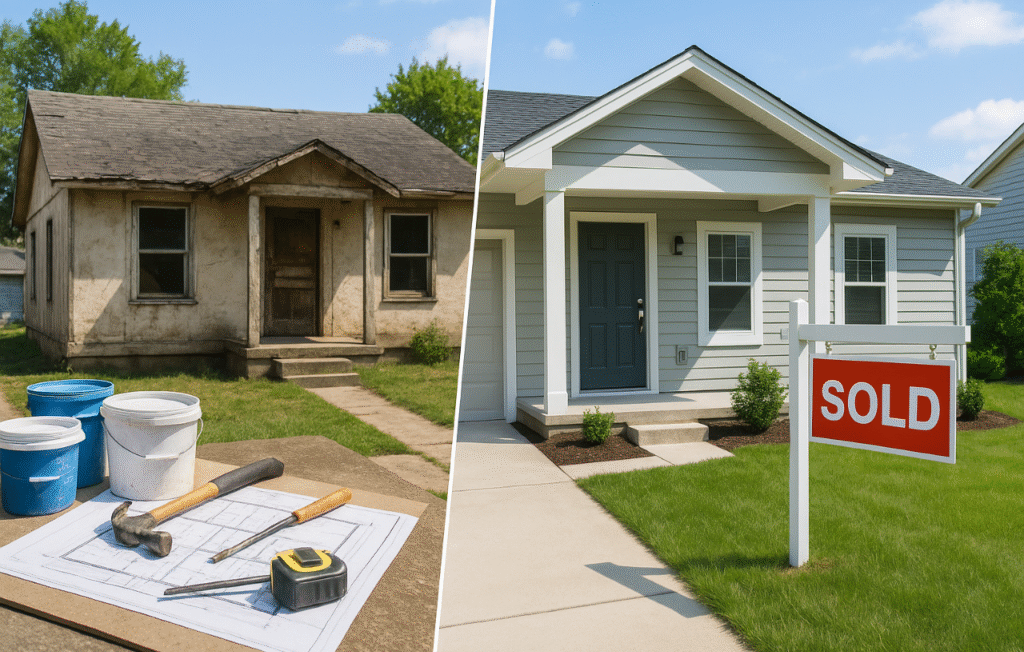Fix and Flip Loans for Beginners: The Complete Guide to Financing Your First Rehab Project

Fix and flip loans are specialized short-term financing options designed specifically for real estate investors looking to purchase, renovate, and sell properties for profit. For beginners entering the real estate investment world, understanding these loans is crucial as they provide the necessary capital to fund both the property acquisition and the renovation costs. Unlike traditional mortgages, fix and flip loans for beginners are structured to accommodate the unique timeline and needs of rehabilitation projects, making them an essential tool in a new investor’s arsenal.
What Are Fix and Flip Loans?
Fix and flip loans are short-term financing solutions typically ranging from 6 to 18 months that enable investors to purchase distressed properties, fund renovations, and sell the improved property for profit. These loans are secured by the property itself and are designed specifically for the fix and flip investment strategy.
Unlike conventional mortgages that focus primarily on the borrower’s personal financial situation, fix and flip loans for beginners place significant emphasis on the property’s potential value after renovations (After-Repair Value or ARV). This project-focused approach makes them accessible to new investors who may not have extensive real estate experience but have identified a promising opportunity.
The typical fix and flip process involves:
- Identifying an undervalued property with renovation potential
- Securing a fix and flip loan to cover purchase and renovation costs
- Completing renovations within budget and timeline
- Selling the property at a profit
- Repaying the loan with proceeds from the sale
This financing structure allows beginners to enter the real estate investment market without needing substantial personal capital upfront.
Key Features of Fix and Flip Loans
Loan Structure
Fix and flip loans for beginners typically come in two main structures:
- Term loans: A lump sum provided at closing that covers both property acquisition and renovation costs. These funds are often disbursed in stages as renovation milestones are completed.
- Lines of credit: Revolving credit lines that allow investors to draw funds as needed throughout the project, providing greater flexibility but sometimes at higher interest rates.
For beginners, term loans often provide more structure and predictability, making them easier to manage for first-time flippers.
Loan-to-Cost, Loan-to-Value, and After-Repair Value
Understanding these three metrics is essential when navigating fix and flip loans for beginners:
Loan-to-Cost (LTC): The percentage of the total project cost (purchase price plus renovation expenses) that the lender will finance. Typically ranges from 70-90% for beginners.
Loan-to-Value (LTV): The ratio between the loan amount and the current property value. Most lenders offer 65-80% LTV for fix and flip projects.
After-Repair Value (ARV): The projected value of the property after renovations are complete. Many lenders will fund up to 65-75% of ARV.
These metrics determine how much money you can borrow and how much cash you’ll need to contribute to the project.
Interest-Only Payments and Fast Approval
Most fix and flip loans for beginners feature:
Interest-only payments: During the loan term, borrowers typically only pay interest on the borrowed amount, with the principal due when the property sells. This reduces monthly carrying costs during the renovation phase.
Expedited approval process: Unlike conventional mortgages that may take 30-45 days, fix and flip loans can often be approved within 5-10 business days, allowing investors to move quickly on opportunities.
Higher interest rates: The convenience and speed come at a cost—interest rates typically range from 7-15%, significantly higher than conventional mortgages.
Requirements to Qualify for a Fix and Flip Loan
While fix and flip loans for beginners are more accessible than traditional financing, lenders still have specific requirements:
- Credit score: Typically 620+ (though some lenders may go lower with higher down payments)
- Down payment: Usually 10-30% of the purchase price
- Cash reserves: Sufficient funds to cover several months of loan payments
- Detailed renovation plan: Itemized budget and timeline for improvements
- Exit strategy: Clear plan for selling or refinancing the property
- Some real estate knowledge: Basic understanding of renovation costs and local market conditions
First-time investors should focus on building these qualifications before applying for their first fix and flip loan.
Types of Lenders for Beginners
Hard Money Lenders
Hard money lenders are private companies or individuals who specialize in short-term real estate loans. For beginners exploring fix and flip loans, hard money lenders offer several advantages:
- Faster approval process (often within days)
- More flexible qualification requirements
- Willingness to fund properties in poor condition
- Experience with renovation projects
The downsides include higher interest rates (typically 10-15%), higher origination fees (2-5% of the loan amount), and shorter terms (usually 6-12 months).
Private Lenders
Private lenders include individual investors, family offices, or small investment groups who provide financing directly to flippers. For beginners seeking fix and flip loans, private lenders may offer:
- More negotiable terms
- Potentially lower interest rates than hard money lenders
- More flexible payment schedules
- Opportunity to build long-term lending relationships
However, finding reliable private lenders requires networking and may take longer than applying with established hard money lenders.
For most beginners, hard money lenders provide the most straightforward path to securing their first fix and flip loan, with private lending relationships developing as they gain experience.
How to Repay Your Fix and Flip Loan
There are two primary strategies for repaying fix and flip loans for beginners:
Selling the renovated property: The most common exit strategy involves selling the improved property at a profit and using the proceeds to repay the loan principal, interest, and fees while retaining the remaining profit.
Refinancing into a long-term mortgage: Sometimes called the “BRRRR” method (Buy, Renovate, Rent, Refinance, Repeat), this approach involves refinancing the property into a conventional mortgage after renovations are complete, then renting it out for ongoing income.
Beginners should have a clear repayment strategy before taking out a fix and flip loan, with contingency plans in case the property takes longer to sell than anticipated.
Tips for Beginners Using Fix and Flip Loans Successfully
For those new to fix and flip loans, these practical tips can help ensure success:
- Build a 20-25% buffer into renovation budgets to account for unexpected issues and cost overruns
- Develop relationships with multiple potential lenders before you need financing to compare terms and have backups
- Start with cosmetic renovations rather than major structural work for your first projects
- Calculate all carrying costs (loan payments, utilities, insurance, taxes) when determining project profitability
- Work with experienced contractors who understand the timeline pressures of fix and flip projects
Conclusion
Fix and flip loans for beginners provide a valuable entry point into real estate investing, offering the necessary capital to fund both property acquisition and renovations. While these loans come with higher costs than traditional mortgages, their flexibility and accessibility make them well-suited for the unique needs of rehabilitation projects.
By understanding the loan structures, qualification requirements, and repayment strategies discussed in this guide, new investors can confidently approach their first fix and flip project with appropriate financing. Remember that successful flipping requires careful property selection, accurate renovation budgeting, and a solid understanding of your local real estate market.
Consider speaking with several lenders to compare terms, connecting with experienced flippers in your area for guidance, and starting with a relatively simple project for your first flip. With proper preparation and the right financing through fix and flip loans for beginners, you can take your first steps toward building a profitable real estate investment portfolio.
